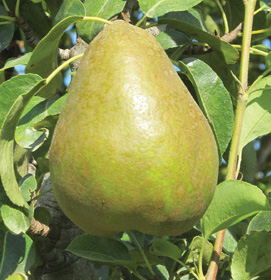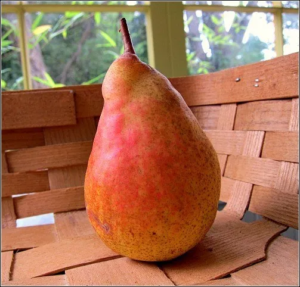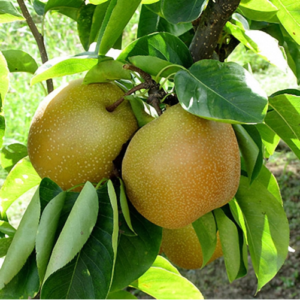Pears & Quince for Whidbey Island 2023
*All of these fruit trees are grown on semi-dwarf rootstock in order to accommodate most home orchards.*
European Pears
Bartlett
Perhaps the most widely grown European pear tree in history and cultivated in America since the early 1800s. Classic bell shaped golden yellow fruit sometimes flushed red. Thin skinned, with creamy white flesh that is sweet and buttery. A multi-purpose pear grown for fresh eating, cooking, dessert, baking or juice. Ripens in September. Pollinate with any other European Pear. Prone to scab. A WSU Mt Vernon recommended variety.
Bosc
A distinctive golden-brown pear with a long neck. Famous for its firm, crunchy, aromatic flesh and sweet, spicy flavor. The firm flesh makes it a great baking pear, but it is also delicious fresh. A very good keeper. Bosc is best picked in late September/early October and stored for several weeks in a cool, dry location. It is then brought into warmth for ripening. Can last up to 6 months in storage. Needs a different European pear variety for a pollinizer. A WSU Mt Vernon recommended variety.
Early Gold

This hardy pear is hard to beat if you’re looking for tasty fruit; sweet and crisp, it is great for eating and holds up well in desserts, baked goods, and when canned. It ripens in early August. And if green/gold fruit isn’t tempting enough, it’s also a great ornamental tree with white flowers in spring and leaves that turn gold to purple in autumn.
Maxie
Is a cross between Max Red Bartlett European and Nijisseki Asian pears, giving us the best of both worlds. Red and yellow in color this fruit is flavorful; sweet, crisp, juicy, and wonderfully aromatic- it is great for fresh eating! This tree blooms in early April and ripens in mid-September. It is also disease resistant.
Orcas
The original tree was found on Orcas Island. Large, beautiful, perfectly pear-shaped yellow fruit, with a red blush. Sweet and juicy, with smooth, buttery flesh. Good for fresh eating, or for canning and drying. Reliable and productive. Disease resistant. Ripens in September. Needs a different European pear variety for a pollinizer. A WSU Mt Vernon recommended variety.
Red Bartlett- Discovered in 1938, this was a sport of Bartlett with unique red skin. Starting crunchy and tart and dark red when under-ripe, this pear finishes bright red, super sweet and juicy when fully ripened. Fruit is ready for harvest early in season. Harvest when mature, but not fully ripe, for best texture. Somewhat disease-resistant.
Rescue
Large, sweet, fruit with mild flavor, has orange-yellow skin. Rescue is a good producer with fruit that ripens in late August. It is great for eating fresh as well as for drying. Well adapted for the Pacific Northwest, it is a vigorous, productive, and reliable variety.
Ubileen

An early ripening pear that has rated high in taste tests. Large yellow pears with a pretty red blush. Delicious eaten fresh with sweet, smooth, buttery flesh. Vigorous and productive. Disease resistant. Ripens in August. Pollinate with a different European pear variety. A WSU Mt. Vernon recommended variety.
Asian Pears
Chojuro
This tree produces medium, round, brown skinned fruit that is mildly sweet & spicy with texture that is firm & crisp. Fruits ripen in mid-August. The Chojuro tree has large, waxy, dark green, foliage that turns a gorgeous red/orange in the fall.
Hosui
Introduced in the 1970s form Japan, this Asian pear is tangy with more acidity than most pears. The fruit is sweet like a European pear, but crisp like an apple. The fruit is large with a gold skin and juicy flesh. Excellent for fresh eating or baking. Ripens in late August. Self-pollinating, but will yield more with a separate pollinator such as ‘Shinseiki’.
Nijisseiki
This is a dessert cultivar bearing medium to large yellow fruits with smooth skin. The white flesh is crisp and mildly sweet. Self-fruitful but better with another variety.
Shinseiki

A beautiful rounded pear with showy yellow skin. Sweet white flesh is crisp and very juicy. Very vigorous and productive. Good disease resistance. Stores very well. Ripens in early to mid-August. Needs a different Asian pear variety as a pollinizer. A WSU Mt Vernon recommended variety.
Espalier European Pears & 4 way Grafted
4 Way Asian Pear – Chojuro, Nijiseiki, Shinseiki, Shinko, Kosui
Espalier European Pear- Bartlett, Red Bartlett, Bosc
Quince ‘Smyra’
Cydonia oblonga is an attractive small tree with large cup-shaped pink and white flowers that yield generous crops of large yellow sweetly aromatic fruit with a flavor reminiscent of pineapple. Used widely for preserves and pectin. Self fertile; ripens in late fall; deserves to be more widely grown.
Need to know which trees pollinize which? Check out these Pollination Charts from Biringer Nursery.
